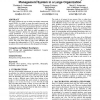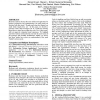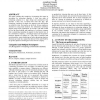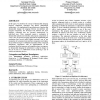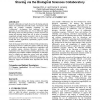CSCW
2004
ACM
14 years 5 months ago
2004
ACM
Emerging technologies offer new ways of using entertainment technology to foster interactions between players and connect people. Evaluating collaborative entertainment technology...
CSCW
2004
ACM
14 years 5 months ago
2004
ACM
This paper examines the way in which a knowledge management system (KMS)—by which we mean the people, processes and software—came into being and evolved in response to a varie...
CSCW
2004
ACM
14 years 5 months ago
2004
ACM
Open-source software development projects are almost always collaborative and distributed. Despite the difficulties imposed by distance, these projects have managed to produce lar...
CSCW
2004
ACM
14 years 5 months ago
2004
ACM
Electronic mail has become the most widely-used application for business productivity and communication, yet many people are frustrated with their email. Though email usage has ch...
CSCW
2004
ACM
14 years 5 months ago
2004
ACM
This paper considers the complexity of measuring the return on investment for technology adoption. A brief case study of technology adoption in a large design and construction fir...
CSCW
2004
ACM
14 years 5 months ago
2004
ACM
In this paper, we introduce the concept of dynamically changing between centralized, replicated, and hybrid collaboration architectures. It is implemented by providing users a fun...
CSCW
2004
ACM
14 years 5 months ago
2004
ACM
Scientific collaboration is largely focused on the sharing and joint analysis of scientific data and results. Today, a movement is afoot within the scientific computing community ...
CSCW
2004
ACM
14 years 5 months ago
2004
ACM
Mission critical applications and legacy systems may be difficult to revise and rebuild, and yet it is sometimes desirable to retrofit their user interfaces with new collaborative...
CSCW
2004
ACM
14 years 5 months ago
2004
ACM
A shared visual workspace allows multiple people to see similar views of objects and environments. Prior empirical literature demonstrates that visual information helps collaborat...
CSCW
2004
ACM
14 years 5 months ago
2004
ACM
A framework is described for analyzing keystroke level data from instant messages (IM). This is unlike other analyses of IM which employ server-based logs of messages. This framew...

